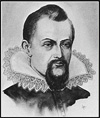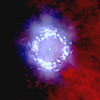CXC Home | Search | Help | Image Use Policy | Latest Images | Privacy | Accessibility | Glossary | Q&A
Q & A
Four hundred years ago, sky watchers, including the famous astronomer Johannes Kepler, were startled by the sudden appearance of a "new star" in the western sky, rivaling the brilliance of the nearby planets. Now, astronomers using NASA's three Great Observatories are unraveling the mysteries of the expanding remains of Kepler's supernova.Q: Why is the supernova named after German astronomer Johannes Kepler?
A: Many people witnessed the bright "new star" that appeared in October 1604. Kepler was so fascinated that he watched the star for a year, making detailed notes about the bright object in a logbook. While working on the laws of planetary motion for which he is well known, Kepler wrote a book called "De Stella Nova" ("The New Star"), in which he describes the bright object. Scientists in the 1940s determined that the new star was a supernova. They named it after Kepler, who was one of the first scientists to study the object.
Q: How often does a star explode as a supernova?
A: In a typical galaxy like our Milky Way, a supernova pops off about every 100 years.
From our earthly vantage point, we cannot see every supernova that occurs in our galaxy because interstellar dust obscures our sight. The Kepler supernova, which occurred 400 years ago, is the last supernova seen inside the disk of our Milky Way (with the possible exception of the Cassiopeia A supernova, for which ambiguous sightings were reported around 1680). So, statistically, we are overdue for witnessing another stellar blast. Curiously, the Kepler supernova was seen to explode 30 years after Tycho Brahe witnessed a stellar explosion in our galaxy. The nearest recent supernova seen was 1987A, which astronomers spied in 1987 in our galactic neighbor, the Large Magellanic Cloud.
Q: Why are supernovas important?
A: All stars make heavy chemical elements like carbon and oxygen through a process called nuclear fusion, where lighter elements are fused together to make heavier elements. Many chemical elements heavier than iron, such as gold and uranium, are produced in the heat and pressure of supernova explosions. These heavy elements enrich the interstellar medium, providing the building blocks for stars and planets, like Earth.
Q: What kind of star produces a supernova?
A: Two types of stars generate supernovas. The first type, called a type Ia supernova is produced by a star's burned-out core. This stellar relic, called a white dwarf, siphons hydrogen from a companion star, thereby making it 1.4 times more massive than our Sun [called the Chandrasekhar limit]. This excess bulk leads to explosive burning of carbon and other chemical elements that make up the white dwarf.
A star that is more than eight times as massive as our Sun generates the second type, called type II. When the star runs out of nuclear fuel, the core collapses. Then the surrounding layers crash onto the core and bounce back, ripping apart the outer layers.
Q: The supernova was first seen in 1604. Is that when the star exploded?
A: No, the explosion occurred thousands of years ago, but the light of the explosion only reached Earth in 1604. Why did it take so long for the light to reach us? It has to do with distance. The supernova is about 13,000 light years away. A light year is the distance that light can travel in a year -- about 6 trillion miles (10 trillion kilometers). Because the supernova is 13,000 light years away, it took 13,000 years for light from the exploded star to reach Earth.
Learn more: Cosmic Lookback Time & Cosmic Distance
Return to Kepler's Supernova Remnant (06 Oct 04)






